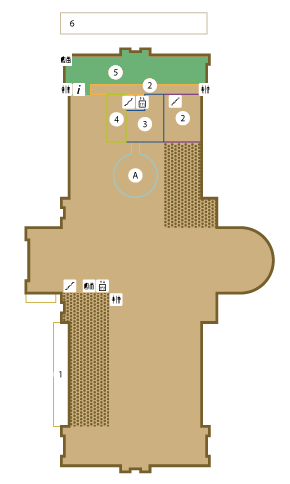Biodiversity
Inaugurated on 27 March, 2012
The refurbishment of the museum permanent exhibitions (CSIC) commenced in 2010 with the Minerals, fossils and human evolution exhibition; we included the Royal Bureau of Natural History in 2011, and finished in March 2012 with the opening of the Biodiversity permanent exhibition.
Located in the Biology wing of the Museum, the exhibition has a net exhibit space of about 1,000 square meters; over a dozen scientists of the National Museum of Natural Sciences, the Biodiversity Foundation, and the Society of Friends of the Museum (SAM, for its acronym in Spanish) have collaborated in its launching.
The goal of the exhibition is to bring attention to the concept of biodiversity, and to raise awareness among the visitors about the importance of biodiversity and the need for its conservation.
The exhibition hosts an abundance of specimens from the museum collections, some of them as emblematic as the African elephant or the bee-eaters of the diorama made by José María Benedito in the early 20th century. There are also unique specimens such as the Tasmanian wolf or the great auk, both extinct, and other seriously endangered species such as the snow leopard, the wood grouse, or the brown bear.
The exhibition is built around three areas
The first area begins with an explanation of the concept of biodiversity, how it is distributed in the different biomes of the world and how it manifests in the forms, colors and relationships of the different organisms that can be found in an ecosystem. This is followed by an artwork that explains the different levels in which we value biodiversity – from genetic diversity to ecosystems – by drawing on the large collections of Insects and Shells of the MNCN. Next, there is a space devoted to show visitors how scientists seek to organise biodiversity by classifying and naming living organisms.
There’s a transition space where visitors learn about the origins of life and the tree of life, featuring a documentary display. The space leads to the second area of the exhibition, entitled Biodiversity as a result of Evolution. Here, visitors can learn about the theory of evolution through the notions of natural and sexual selection. There are also different sections revealing the genetical basis of the evolution, as well as the relationship between fossils and evolution. Additionally, a big showcase with a diverse representation of reptile, mammal and bird skeletons allows the visitor to have a go at compared anatomy.
Finally, there is an artwork telling the story of the geological extinctions of remote times - and the more recent ones, due to human activity; this gives way to the Wildlife Conservation area, which includes some of the most valuable specimens of the museum representing extinct species, such as the Tasmanian wolf or the great auk. The area also addresses some of the questions that wildlife conservation brings up in today’s society: What specimens and items shall we curate, and where? How and why should we curate them? The exhibition ends in an area dedicated to the research conducted by the scientists of the MNCN with the aim of enhancing conservation and protection of species that are threatened by extinction at different levels (with examples such as the wood grouse, the Iberian lynx, the brown bear, the ribbed Mediterranean limpet or the Mhorr gazelle).
This is the first bilingual exhibit for Spanish and English-speaking audiences launched by the museum. We would particularly like to praise the effort made by the entire staff of the Museum to showcase a large representation of its collections, which amounts to over 1,000 specimens. Many of these specimens have been recently restored, while some others, such as the 21-metre long whale skeleton, are new incorporations to the halls of the MNCN.
Another highlight of this contemporary and dynamic exhibit is the active participation of the researchers, which makes it scientifically valuable. For this reason, Biodiversity is conceived as a permanent but active exhibition, which is updated with new elements, items and specimens as new discoveries emerge.

Videos
Planta baja








